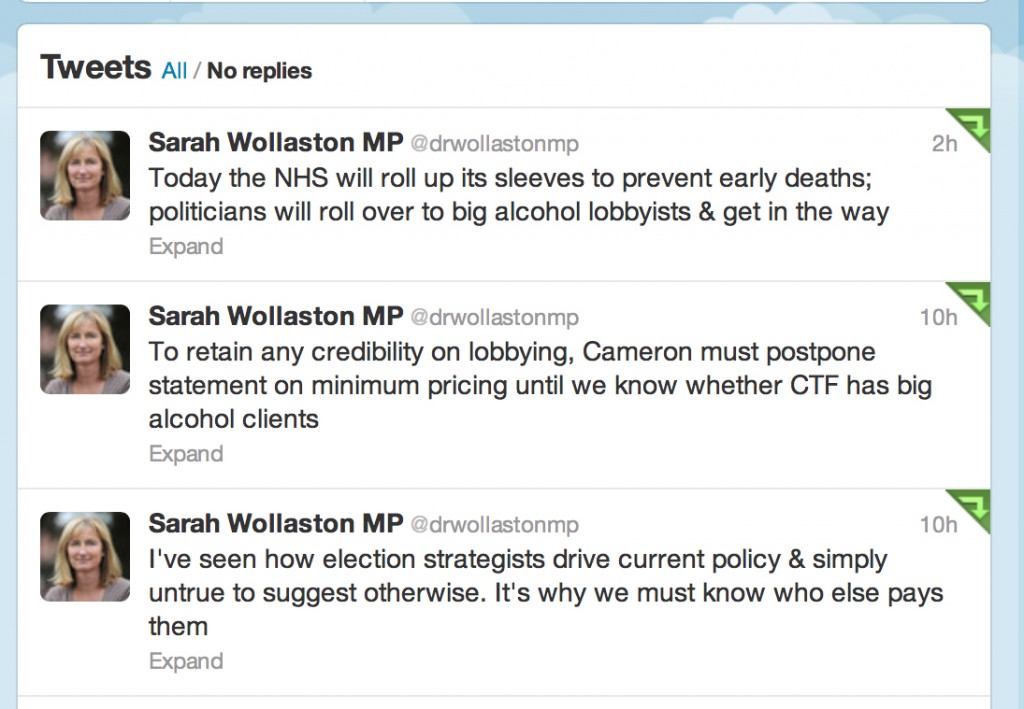Home » Posts tagged 'cigarettes'
Tag Archives: cigarettes
Should e-cigarettes be available on the NHS?
 Addicts are great customers, they have a huge appetite for your product and they keep coming back.
Addicts are great customers, they have a huge appetite for your product and they keep coming back.
That of course is the market-driven view of public health. A coherent national public health policy should consider the evidential impact of measures on the health of its citizens.
The last few years have indeed seen a public health which appears to have been somewhat determined by the phenomenon of ‘corporate capture’, such as the interests of corporates rather than public health physicians. This is of course partly a reflection of the current government in office, and spans across a growing number of policies including obesity, packaging of cigarettes, and pricing of alcohol.
A buzzword in management circles has been ‘disruption‘. It is felt that early digital cameras suffered from low picture quality and resolution and long shutter lag. Quality and resolution are no longer major issues and shutter lag is much less than it used to be. The convenience and low cost of small memory cards and portable hard drives that hold hundreds or thousands of pictures, as well as the lack of the need to develop these pictures, also contributed to the successful adoption of these disruptive technologies. Digital cameras have a high power consumption (but several lightweight battery packs can provide enough power for thousands of pictures).
According to Wikipedia, a disruptive innovation “is an innovation that helps create a new market and value network, and eventually goes on to disrupt an existing market and value network, displacing an earlier technology”. It is a term used to describe changes that improve a product or service in ways that the market does not expect.
Disruptive technologies have created new industries and new markets. They have also rendered others obsolete and outdated. They provided consumers with something they did not know they wanted. The economist Joseph Schumpeter referred to this process as “creative destruction.” Early investors in these companies certainly took on a lot of risk. There was no way to know whether or not an idea would be profitable. After all, these ideas had no track record.
The American investment banking firm Goldman Sachs earlier this year released a list of eight disruptive themes that have the potential to reshape their categories and command greater investor attention in the near future. Electronic cigarettes were listed as one of these eight markets investors should keep an eye on, for their potential to transform the tobacco industry.
As described in “E Cigarette Forum”,
The little vaping companies that make alternative devices may not make it into the fortune 500 or onto the boards of the NYSE, but they will survive because they have a passionate clientele. They’re like the little mammals that scurried around the massive feet of the dinosaurs at the end of the Jurassic, 65 million years ago, just as the big guys were about to go belly up. Bet on the little guys. They’ll survive.
On October 8th 2013, the European Parliament is to vote on a proposal to regulate the devices as if they were medical products. E-cigarettes (“e-cigs”), which allow users to inhale nicotine-laced vapour instead of tar-clogged smoke, are a growing market, set to top $1bn in the next three years. Smoking is falling in most rich countries, but “vaping” is rising. In Europe, 7m people are thought to be using e-cigs, which vaporise a solution containing nicotine without the toxins from burning tobacco. Sales of e-cigs in America may treble this year, according to figures from Bonnie Herzog of Wells Fargo, a bank. She thinks their consumption could overtake that of ordinary cigarettes in a decade.
An “e-cig” is composed of a mouthpiece, a liquid nicotine cartridge, a heating element and a battery. When the user inhales on the e-cig, the heating element is activated. The liquid nicotine cartridge is heated and creates a vapor. This is what the user inhales. It is odourless. It doesn’t contain any of the other chemicals or tar found in traditional cigarettes.
E-cigs may be far safer than normal cigarettes and at least as good at getting people to quit smoking as nicotine patches and gum, but they too are based on that addictive substance. Manufactured by hundreds of suppliers using materials from China and elsewhere, the quality and labelling of e-cigs on sale are known to be uneven.
E-cigs can be smoked indoors. Once again, there are no noted effects of secondhand vapour. The vapour that is exhaled has little to no odour. Bar and club owners may even be becoming fans of e-cigs. Users who buy them are more likely to stay in the bar and consume more drinks than they otherwise would. This may add to the ‘coolness’ and convenience factor of these disruptive new products. There are a number of possible suggested benefits.
There is a noted reduction in side effects commonly reported by smokers. Some of these side effects are shortness of breath, dry mouth and headaches. Along with reduction of side effects, there is no secondhand smoke. The vapour that the user exhales quickly vanishes and does not appear to cause harm to bystanders.
A ‘quick reference guide’ for ‘smoking cessation services’, from NICE, published in February 2008 gives an overview of what was perceived then could or should be offered on the NHS to help people give up smoking. This evidence-based guidance presents the recommendations made in ‘Smoking cessation services in primary care, pharmacies, local authorities and workplaces, particularly for manual working groups, pregnant women and hard to reach communities’. It provides a rationale for who could provide smoking cessation services (as it predates the £3bn top-down reorganisation, it refers to a critical rôle for PCTs and SHAs), what pharmacotherapies might be prescribed and for whom (and where they should not be prescribed), which patient groups might be beneficially targeted, and how effectively educational and training resources might be allocated.
It is no secret that despite public health efforts the popularity of electronic cigarettes has increased at a rapid pace in recent years. E-cig sales have doubled in the last two years and they are estimated to reach $1billion in retail sales in 2013. According to a Gallup poll, 74% of smokers want to quit, and Goldman Sachs analysts believe the electronic cigarette is “the most credible alternative to conventional cigarettes in the market today”.
This investment giant estimates electronic cigarettes could reach $10 billion in sales over the next few years and account for over 10% of the total tobacco industry volume and 15% of the total profit pool by 2020. In April 2012, one of the big cigarette companies threw its hat in the ring. This was Lorillard, maker of Newport and other cigarette brands. They spent $135 million on the purchase of blu e-cigs. They’ve seen a lot of success with the brand. Sales have grown from $8 million in in the second quarter of 2012 to $57 million in the second quarter 2013. This is a gain of more than 600%. Lorillard claims they hold around 40% of the total e-cig market share. So of course Big Tobacco is eager to get in on the act, and as Hargreaves notes, cigarette manufacturers Lorillard, Reynolds American, Imperial Tobacco, British American Tobacco, and Altria are all bringing out e-cigs, along with newer companies like Vapor and privately-held NJOY.
There are, of course, risks to this growth. One realistic threat is the tightening of the manufacturing and product standards, or bring in a specific set of rules rather like those governing cosmetics. However, any government would have to be motivated to do this, and, following evidence for ‘corporate capture’ in English policy since the election of the UK Coalition government in 2010, e-cigs are likely to experience an ‘easy ride’.
But there are other considerations. Electric smokes compete with cigarettes yet do not in most places face the same restrictions, to say nothing of excise taxes. They compete with smoking-cessation products yet do not usually have to secure prior approval for products or make them to pharmaceutical standards. If they are required to do either, their price will rise, variety will fall and the uptake by consumers, who are overwhelmingly smokers, will be cut.
Furthermore, the World Health Organisation does not encourage them. America’s Food and Drug Administration is expected to propose restrictions in October. In 2009 it claimed that e-cigarettes were unapproved medical products, but a court said they should be regulated as tobacco products instead. Health authorities worldwide are struggling to deal with this new way of getting a nicotine kick. E-cigarettes are sold as leisure products and as such are covered by safety and quality standards wherever these exist and are implemented. But leaving them, like shoes or beds, to such “catch-all rules” makes some regulators uneasy. The most obvious is the involvement of the FDA. E-cig companies are anticipating that the FDA will get more heavily involved in regulating the e-cig market. This is a known risk currently being priced into e-cig dividends.
If, conversely, FDA regulation is passed, this could actually help their stock price. It would grant a degree of certainty in the minds of investors. It could also have the effect of crowding out some of the smaller players. It may also have the effect of boosting consumer confidence in the e-cigarettes. E-cigarettes, which allow users to inhale nicotine-laced vapour rather than tar-clogged smoke, are a growing market (expected to top $1billion in the next three years) but some countries including Brazil, Norway and Singapore have already banned the devices. The Medicines and Healthcare Products Regulatory Agency (MHRA) have already announced that e-cigarettes will be regulated in the UK as a non-prescription medicine. In the US, the FDA has previously warned makers for violating good manufacturing practices and making unsubstantiated drug claims.
The goal, according to Clive Bates, a former director of Action on Smoking and Health, a British campaigning group, and a tireless advocate of e-cigarettes, is not to lose the chance of millions of smokers switching in whole or in part to a relatively benign alternative. “The market is producing, at no cost to the taxpayer, an emerging triumph of public health,” he says.
In terms of the market economy, regarding the way Big Tobacco will be affected by the evolution of electronic cigarettes, Goldman Sachs predicts Lorillard will be the biggest beneficiary of the shift. after its acquisition of Blu ecigs. Blu commands 40% of e-cigarette market share and and it is expected its sales will account for 5% of Lorillard’s overall sales this year. Having a dominant e-cig brand in its portfolio puts the company in a favorable position, and could be included in even the most ‘ethical’ of pension funds in an investment portfolio.
However, perhaps the biggest threat to public health might be the market philosophy, which the current Coalition of the Conservatives and the Liberal Democrats appear to be sympathetic towards. As the Conservative Party begin their annual party conference in Manchester, it is possibly worth noting the criticism of Dr Clive Peedell, Co-Chair of the National Health Action Party, of an article by Nigel Edwards in Health Services Journal.
Peedell described that,
“In addition, market theory in the form of public choice theory rejects the idea of medical professionalism and the public service ethos. James Buchanon, “the father” of this theory admitted in a BBC documentary (“The Trap”, by Adam Curtis) that he didn’t believe in the concept of the public service ethos. Julian Le Grand famously used the “Knights and Knaves” metaphor to explain this. The solution to “rent seeking behaviour” is the discipline of the market. This would turn “pawns in queens”. The introduction of the market also explains the rise of New Public Management (managerialism), which favours narrow economic priorities and micro-management practices (e.g audit, inspection, performance indicators, league tables, monitoring and centrally imposed targets) over professional judgment [6]. (I was politicised by MMC, by the way, because I rejected its anti-professional tick box aims. It was about delivering a new breed of doctor to suit the needs of employers in the new healthcare market). And there’s more! (as Frank Carson used to say). Markets undermine the social contract between doctors and patients and damage the doctor patient relationship, because decision making becomes increasingly finance based rather than needs based. It is no coincidence that the American medical profession lost public support faster than any other profession during the rapid commercialisation of the US healthcare system in the 1970/80s.”
Libertarians might argue that citizens individually are ‘free’ to make their own choices, in the same way that ‘fat people may choose to become fatter’ due to lack of self-restraint on food. However, such crass stupidity ignores the sheer biology of how some human beings control their intake. Indeed, the first rule of recovery in substance abuse and misuse clinics in the ‘Twelve Steps’ program is for the addict to admit “powerless” over their drug of choice. Ultimately, like many of these decisions, it will come down to a cost-benefit analysis, but such sums are notoriously difficult. How much money should the NHS spend ‘from hard-working taxpayers’ money’ on such treatments, when people ‘choose to smoke’ or ‘choose to become fat’ in the rather prejudiced jaded view of the health of others? Some people might prefer this health responsibility to be offloaded who can exploit maximal rent-seeking behaviour in making a profit, in much the same way that the ‘first mover advantage’ of any Big Pharma that unlocks the secret to NHS ‘Big Data’ might become a multi-billionaire.
Deciding on the health benefits of the e-cig would have been a difficult enough job. Pile on this the consideration of this Government which knows where its priorities lie, the terrain is even more uncertain possibly.
Government statement on consultation on standardised packaging of cigarettes
Links:
https://www.gov.uk/government/news/consultation-on-standardised-packaging-of-tobacco-products
https://www.gov.uk/government/consultations/standardised-packaging-of-tobacco-products
The summary report of the responses to the public consultation on standardised packaging of cigarettes has recently been published by the Department of Health. There were more than 668,000 responses to the consultation. The opinions were highly polarised with strong views put forward on both sides of the debate. There was also widespread use of campaigns and petitions by a number of organisations. Having carefully considered these differing views, the Government has decided to wait until the emerging impact of the decision in Australia can be measured before making a final decision on this policy. Currently, only Australia has introduced standardised packaging, although the Governments of New Zealand and the Republic of Ireland have committed to introduce similar policies. Standardised packaging, therefore, remains a policy under consideration.
Health Secretary Jeremy Hunt said:
The UK is known the world over for its comprehensive, evidence-based tobacco control strategy, and we are continually driving down smoking rates through our range of actions.
Obviously we take very seriously the potential for standardised packaging to reduce smoking rates, but in light of the differing views, we have decided to wait until the emerging impact of the decision in Australia can be measured, and then we will make a decision in England.
This decision is an important one and whilst we keep it under review, we’ll be continuing to implement our existing plan to reduce smoking rates through ending the display of tobacco in all shops, running national behaviour change campaigns to encourage smokers to quit and through supporting local authorities to provide effective stop smoking services.
Many decisions are subconscious. That’s what marketing people manipulate to make loadsamoney.
It is actually very hard to tell whether this Government’s actions are a result of a fundamentally libertarian ideology, or whether there is simply no ideology at all – they simply wish to allow their “corporate friends” to make lots of money (which as such is not an ideology). The screw-up over plain packaging in cigarettes can be interpreted at a number of different levels. One is how plausible transparency in the Government is: whilst the evidence concerning Lynton Crosby himself (and his company) is unconvincing, the lengths that international tobacco companies might go through in influencing public health policy are interesting. It could be argued that tobacco companies are simply not keen on regulation, but that does not stop Philip Morris initiating legal action at the drop of the hat. There are wider subtler inherent contraindications in the analysis of the power of the State and its rôle in public health too which will cause problems ultimately. A strong undercurrent has been the notion of “choice”, typified by Tim Kelsey’s approach to the use of data in decision-making of patients, or “customers of the NHS” as called by some. The idea that “regulation is bad” is of course fully consistent with a political philosophy from the Conservative Party, and while the Labour Party could rightly be accused of a somewhat authoritarian, “nanny state” tinge to its last attempt at office and power, the idea of the “public good” continues to gather much support in many jurisdictions.
The government has actually now mutualised its “Nudge” unit, but “Nudge” was the future once. The centrality of using behavioural insights to the Coalition government is such that it entered formal written agreement between the Conservative and Liberal parties, in the foreword by the two party leaders and their juniors:
“There has been the assumption that central government can only change people’s behaviour through rules and regulations. Our government will be a much smarter one, shunning the bureaucratic levers of the past and finding intelligent ways to encourage support and enable people to make better choices for themselves”.
Nudge is an interesting foray into consumer behaviour, and part of the problem in this is that human beings are often irrational (and certainly will make suboptimal decisions on the basis of dodgy data.) Consumer behaviour is ultimately determined by cognitive processes, such as perception, selective attention, and memory, which is why the approach to “big data” fails inherently to capture individual differences. This is a problem in planning public policy, but why should the field of marketing and economics be so interested in packaging if it does not matter? The actual evidence provides that product packaging is an important tool for suppliers to communicate with consumers.1 Tobacco manufacturers have effectively used cigarette pack design, colours, and descriptive terms to communicate the impression of lower tar or milder smoke while preserving taste “satisfaction”. Smokers’ beliefs about a given product are likely to be shaped in part by the descriptors, colours, and images portrayed on the pack and in related marketing materials.
In the US jurisdiction, “The Framework Convention on Tobacco Control” (Article 11) calls for a ban on misleading descriptors in an effort to address consumer misperceptions about tobacco products. New regulations contained in the Family Smoking Prevention and Tobacco Control Act of 2009 (FSPTCA) prohibit tobacco companies from labelling cigarette packs with terms such as light, mild, or low after June 2010. However, experience from countries that have removed these descriptors suggests that cigarette marketers manage to circumvent the intended goal of the regulation by using different terms, colours, or numbers to communicate the same messages. Specifically, recent research has shown that consumers in the United Kingdom and Canada, which have removed “light” and “mild” descriptors, perceive cigarettes in packs with lighter colours as less harmful and easier to quit compared to cigarettes in packs with darker colours. Colour is a good example of non-verbal marketing signal, which has an important influence on our daily lives. The underlying emotions that colours evoke have been cultivated since birth and vary depending on age, geographic location, and gender (e.g. blue for boys, pink for girls). Colour, it affects, affects our moods and feelings, and research suggests that it has a physical effect as well, influencing the hormones that control our emotions.
Studies have shown that color:
- Increases brand recognition by up to 80%
- Improves readership as much as 40%
- Increases comprehension by 73%
- Can be up to 85% of the reason people decide to buy
Bansal-Travers, O’Connor, Fix,and Cummings (Am J Prev Med 2011;40(6):683–689) showed 193 participants array of six cigarette packages (altered to remove all descriptive terms) and asked to link package images with their corresponding descriptive terms. Participants were then asked to identify which pack in the array they would choose if they were concerned with health, tar, nicotine, image, and taste. Participants were more accurate in matching descriptors to pack images for Marlboro brand cigarettes than for unfamiliar Peter Jackson brand (sold in Australia). Smokers overwhelmingly chose the “whitest” pack if they were concerned about health, tar, and nicotine. Smokers in the U.S. associate brand descriptors with colours. Further, white packaging appeared to most influence perceptions of safety.
Tobacco studies indicate that health-related information in cigarette advertising leads consumers to underestimate the detrimental health effects of smoking and contributes to their smoking-related perceptions, beliefs, and attitudes. Paek and colleagues (Paek et al., 2010) examined the frequencies and kinds of implicit health information in cigarette advertising across five distinct smoking eras covering the years 1954-2003. Most notably, a majority of the cigarette ads portrayed models smoking, lighting, or offering a cigarette to others. Rooke and colleagues (Rooke et al., 2010) investigated how tobacco displays are used at the point of sale (PoS) as an important means for the tobacco industry to communicate with consumers. With regulations prohibiting PoS displays recently having come into force in Ireland, this is an increasingly important issue. Over 100 retailers were visited, with interviews taking place on site. Information was gathered on the type and size of tobacco display, who was paying for the display, requirements and incentives, and visits by industry representatives. The majority of retailers had gantries provided by tobacco companies. A minority of these were fitted with automated dispensers called retail vending machines. Attractive lighting and colour were often used to highlight particular products. Wakefield and colleagues (Wakefield et al., 2002) investigated the role of pack design in tobacco marketing. A search of tobacco company document sites using a list of specified search terms was undertaken during November 2000 to July 2001. Many smokers are misled by pack design into thinking that cigarettes may be “safer”. There is a need to consider regulation of cigarette packaging.
The World Health Organization applauded Australia’s law on plain packaging noting that “the legislation sets a new global standard for the control of a product that accounts for nearly 6 million deaths each year” The Cancer Council of Australia hailed the passing of the legislation, stating, “Documents obtained from the tobacco industry show how much the tobacco companies rely on pack design to attract new smokers….You only have to look at how desperate the tobacco companies are to stop plain packaging, for confirmation that pack design is seen as critical to sales.” Don Rothwell, professor of international law at the Australian National University, noted that Philip Morris was pursuing multiple legal avenues. The Notice of Arbitration under the bilateral investment treaty between Hong Kong and Australia has a 90-day cooling off period after which the case would most likely be sent to the International Centre for Settlement of Investment Disputes in Washington. He stated that Philip Morris was most likely aiming for the Australian Government to back down, or failing that, to sue for compensation. He said the questions to decide are whether the legislation means that Australia would acquire property by the imposition of these rules and if this legislation is a legitimate public-health measure. Gavin Allen of the Daily Mail newspaper reported that the Philip Morris lawsuit could cost the Australian government “billions”. He also noted that the Australian law is being closely watched by other governments in Europe, Canada and New Zealand. In 2005, the World Health Organization urged countries to consider plain packaging, and noted that Bhutan had banned the sale of tobacco earlier in 2011.
As the latest row over the role of big money in politics hit Downing Street, Paul Burstow, who was a health minister until September last year, said Crosby should either quit or be sacked by Cameron after it emerged that his lobbying firm works for global tobacco giant Philip Morris. Other Liberal Democrats also made clear they were furious and would fight to ensure Crosby was removed from any role in which he could influence health or any other coalition policy. Amid the growing furore, the Tory chairman of the all-party select committee on health, former health secretary Stephen Dorrell, announced that his committee would look into why the government had changed its mind on the question of cigarette packaging.
This is a very serious issue. The Observer editorial was devoted to it this morning.
As the Smokefree Action Coalition points out, cigarettes are the only legal product sold in the UK that kill their consumers when used exactly as the manufacturer intends. Even if the government remains unconvinced of the wisdom of plain packaging, an alliance of MPs, charities and health experts and the Faculty of Public Health disagree, as does the public. A YouGov poll in February found that 64% of the public is also in favour. So why the sudden U-turn?
The tobacco giants are spending £2m in a campaign against standardised packaging. Critics also point out that the industry has its very own Trojan horse inside Number 10, in the shape of Australian Lynton Crosby, the Conservatives’ general election co-ordinator. Hours after the decision to postpone plain packaging, it emerged that Crosby’s company, CTF, has been advising Philip Morris Ltd in Britain since November. Now there are calls for an inquiry. As the lacklustre bill on lobbying moves through parliament, Deborah Arnott, chief executive of the health charity Action on Smoking and Health, rightly says: “David Cameron has called political lobbying the ‘next big scandal waiting to happen’. Happen it has, right in 10 Downing Street.” Tory MP and GP Dr Sarah Wollaston, who also campaigns for price controls on alcohol, aptly tweeted: “RIP public health. A day of shame for this government; the only winners big tobacco, big alcohol and big undertakers.”
“There is another fundamental contradiction in nudging, particularly in the context of the declared intent to increase a sense of individual responsibility outlined by the Prime Minister. Whilst there may be an attempt to provide at least token interference transparency to preserve the possibility of exposing a ‘nudge too far’, this also underlines how far this process is from one that encourages greater learning about problems and how the individual might take on some responsibility for their management. Behaviouralism directs us away from building the renewed sense of personal and social responsibility the Coalition government has set out as fundamental to its mission.”
Therein lies the rub perhaps. While promoting “individual choice” through nudges, the policy has inadvertently discouraged personal responsibility, and especially responsibility for other members of the community. The critical problem is that the whole is not the sum of its constituent parts, and while FA Hayek’s “The Road to Serfdom” was hailed by Margaret Thatcher (whose remark was passionately argued by the Bishop of London at her funeral to have been misquoted), cognitive neuroscience acknowledges that individuals often make the “wrong” choices – wrong for them individually, and also wrong for society. Many decisions are unconscious, and indeed that is what the whole of the profit-generating marketing industry is devoted to manipulating. But the fact that these decisions are unconscious tells you exactly what is fundamentally incorrect about the libertarian analysis. People don’t know why they’re making certain decisions: they are not in control at all. The advertisers are. And more importantly, they cannot learn from their decision-making process. Public health, for all its possible faults, is firmly against this philosophy.
References
Paek HJ, Reid LN, Choi H, Jeong HJ. (2010) Promoting health (implicitly)? A longitudinal content analysis of implicit health information in cigarette advertising, 1954-2003. J Health Commun. 2010 Oct;15(7):769-87. doi: 10.1080/10810730.2010.514033.
Rooke C, Cheeseman H, Dockrell M, Millward D, Sandford A. Tobacco point-of-sale displays in England: a snapshot survey of current practices. Tob Control. 2010 Aug;19(4):279-84. doi: 10.1136/tc.2009.034447. Epub 2010 May 14.
Wakefield M, Morley C, Horan JK, Cummings KM. (2002) The cigarette pack as image: new evidence from tobacco industry documents. Tob Control. Mar;11 Suppl 1:I73-80.
Bansal-Travers, M, O’Connor, R, Fix, BV, Cummings, KM (2011) What Do Cigarette Pack Colors Communicate to Smokers in the U.S.? Am J Prev Med 2011;40(6):683– 689





